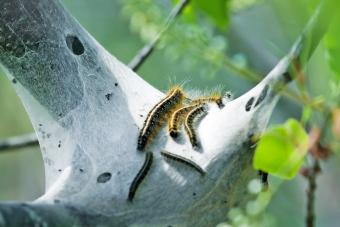
The fall webworm is native to North America, where it is common from Mexico to Canada. Even though these pests usually cause very little long-term damage, most gardeners hate them. The webs are appropriate decorations for the Halloween season, but other than that, most gardeners aren't happy to find them in their gardens.
Identifying Webworms
If you have a webworm infestation in your garden, you'll likely notice the webs before you notice the caterpillars. If you see large, light gray webs enclosing branch tips of your trees in late summer to early fall, you have webworms. They're especially easy to spot once the leaves start falling and the branches are bare.
The caterpillars are covered with long gray-white or yellow-white hairs. There are two kinds of webworms: the blackheaded and the redheaded.
- The blackheaded caterpillars are more yellow in color and have two rows of black spots.
- The redheaded caterpillars are more tan in color and have orange or reddish spots.
Webworm caterpillars make distinctive jerking movements, moving in unison, if their nest is disturbed. Fully-grown caterpillars are about one inch in length and have a fuzzy appearance.
The adult moths have a wingspan of about one and a half inches. They are pure white and may have black wing spots. The moths lay their eggs on the underside of host leaves.
Webworm Food Sources
Fall webworms feed on more than 100 species of trees in North America. Pecan, walnut, American elm, hickory, fruit trees, and some maples are their favored food source in eastern areas, and while alder, willow, cottonwood, and fruit trees are commonly attacked in the west.
The webs are usually concentrated in limited areas, so relatively little damage is inflicted on the host trees.
Webworm Life Cycle
Adult moths lay their eggs on the undersurface of leaves. The caterpillars hatch about a week later and immediately spin a web over the foliage they are eating. As they grow, they enlarge the web to cover more foliage. If the population is large, several branches or even an entire small tree can be encased in webbing. The caterpillars mature in about six weeks and drop to the ground to pupate.
In warm areas, up to four generations can be produced in a year. A heavy infestation can defoliate a tree. In colder areas, this pest overwinters on the ground, and the moths emerge the following spring and summer.
Webworms have periodic population explosions. Outbreaks occur every four to seven years, and each outbreak may last for two to three years until natural control agents reduce the activity.
Getting Rid of Webworms
Over 86 different predators prey on webworms, so natural controls are normally effective. Parasitic flies, stink bugs, birds, and social wasps (yellow jackets and paper nest wasps) are the most important predators.
A specific bacteria, Bacillus thuringiensis variety kurstaki (B.T. for short), is effective against webworms and is not damaging to beneficial predators. It should be used in late summer, while the caterpillars are still small. The kurstaki variety is the most effective, so be sure to read the label carefully before buying. When you spray, be sure to thoroughly cover all the leaves next to the webs.
Insecticide sprays and systemic insecticides can be used, but they're not usually necessary. Natural predators and B.T. are the best options.
Other Pests Similar to Webworms
Webworms are frequently confused with the tent caterpillar, which is a far more destructive pest. However, the tent caterpillar is primarily active in spring, while webworms are noticeable in the fall.
Tent caterpillars make smaller webs in the crotch of branches, unlike webworms, which make large webs at the tip of branches. Webworms feed only within their webs, while tent caterpillars eat in the open and return to their webs at night or on cold, wet days. Webworms are yellow-white, but tent caterpillars are black with a white stripe.
In addition to tent caterpillars, webworms are often confused with gypsy moth larvae, which don't have a white stripe down the back, and have large red spots down both sides. Gypsy moths are very invasive and damaging to trees, but they're active in late spring and early summer, rather than in fall.
Unsightly, but Not a Danger to Plants
Overall, the most important thing to remember about fall webworms is that they don't harm plants and they can usually be controlled by the other wildlife in your garden. They're not pretty, and the webs can definitely be unsightly, but it's easy to simply prune any branches that are webbed up and get your garden back to its normal, web-free appearance.







